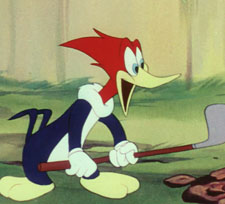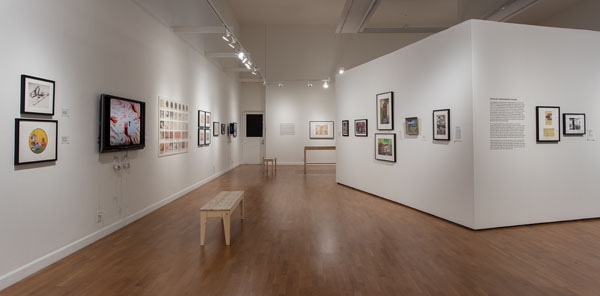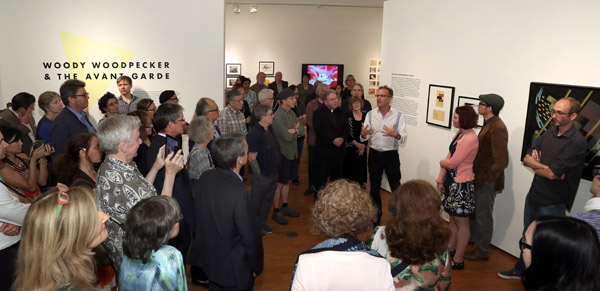As the curator of the just-opened exhibit, Woody Woodpecker & The Avant-Garde at the Laband Art Gallery, I confess that one of my favorite portions of the show is a side-by-side video display of Woody in Barber in Seville and the Bolshevik uprising from Sergei Eisenstein’s classic October. It is well documented that director Shamus Culhane was influenced by Eisenstein, but these two clips reveal odd similarities. They both have an absurd theatricality and, seen next to Woody, the live-action violence of the Czarists seems completely slapstick.
Woody also has an inspired little moment in Ski for Two (1946) where he performs a Cossack kick-dance and sings “The Sleigh (à la Russe)” as he skis through the trees of a snowy forest. This was the character from the years of World War II, and no one could doubt Woody’s patriotic fervor, but he sure did seem to put the ‘Red’ into red, white, and blue. Although this moment in time is often met with disbelief by so many who only remember the tense decades of the Cold War, the U.S. and Soviet Union had been pals of convenience during their military alliance against Germany.
 When Shamus Culhane, the wartime director of Woody Woodpecker cartoons, attended evening film screenings at the American Contemporary Gallery (ACG) on Hollywood Boulevard, he was among a crowd that not only esteemed the luminaries of Soviet cinema but also which had members sympathetic to the ideals of communism. ACG at one point even held a show in which war posters displayed on its walls were provided by the Soviet news agency Tass.
When Shamus Culhane, the wartime director of Woody Woodpecker cartoons, attended evening film screenings at the American Contemporary Gallery (ACG) on Hollywood Boulevard, he was among a crowd that not only esteemed the luminaries of Soviet cinema but also which had members sympathetic to the ideals of communism. ACG at one point even held a show in which war posters displayed on its walls were provided by the Soviet news agency Tass.
At the time, there was nothing subversive or radical about this. The U.S. government proclaimed the Soviet Union our allies and officially this sort of outreach and admiration got a thumbs-up from Uncle Sam. The founder of the gallery was, according to Culhane, a “typical Greenwich Village Bohemian” who had moved to Los Angeles. A coterie of her event organizers was inclined to promote leftist causes and the gallery was a champion for the progressive movement.
In May 1942, the American Contemporary Gallery mounted an exhibit by African-American artist Thelma Johnson Streat. Because she had painted a poignant picture of a black sailor in Navy uniform, Streat received death threats from the Ku Klux Klan. That’s right, the KKK was even active in Los Angeles then, and ACG was clearly the sort of place where the brave convictions of a few were challenging the norms of racial inequity. (Thanks to Carolyn Peter for culling that from the L.A. Times archive).
As for the Walter Lantz studio, the spirit of the changing times was sweeping through its halls. From a Michael Barrier interview with Roger Armstrong, here is a fascinating recollection about an assistant animator named Alex Ignatiev, a Russian émigré, who played this interesting role at Lantz:
I remember Alex Ignatiev was teaching us all Russian, he was teaching us the Cyrillic alphabet. At that time, we were palsy-walsy with Russia, and nothing would do but that everybody in the studio was learning Russian. Alex was teaching us: he was the son of a White Russian refugee. He spoke Chinese, Russian, and English; the whole family had come [to the United States] by way of China. His father had been a general in the Czar’s army, and they came out [of Russia] with nothing.
 It is easy to imagine Culhane hanging with a left-leaning crowd of artists and social activists at a gallery on Friday nights, but quite another to think of the animators practicing their Russian while they drew Woody for these classic cartoons! Considering that one room in the studio was off-limits, requiring a security clearance to enter—on account of the war training films being made in there—this anecdote makes a point about the ready acceptance of Russian before the war was over.
It is easy to imagine Culhane hanging with a left-leaning crowd of artists and social activists at a gallery on Friday nights, but quite another to think of the animators practicing their Russian while they drew Woody for these classic cartoons! Considering that one room in the studio was off-limits, requiring a security clearance to enter—on account of the war training films being made in there—this anecdote makes a point about the ready acceptance of Russian before the war was over.
These are the little artifacts of history that can serve as revealing snapshots for us. In designing this new exhibit, I have tried as much as possible to capture this collision of politics and ideology. Knowing that there was sympathetic regard for communism brings into focus two sides of an on-going political debate we know that Culhane used to have with his colleague Bugs Hardaway.
The unionizing of the animation studios a few years earlier, including the polarizing effect of the 1941 Disney strike, would have inclined animators to be pro-labor. Of course, the war years were notably a period of sacrifice from so many. The cartoon industry did its part, facilitating an enormous visual education and propaganda effort. And then when this world conflict finally ended, the ease with which some people had embraced an interest in left-wing politics—“palsy-walsy with Russia”—came to be forcefully challenged by McCarthyism and the resurgent Red Scare.

As I have mentioned in previous posts, an explicit goal of Woody Woodpecker & The Avant-Garde is to bring attention to the overlooked American Contemporary Gallery, which so richly deserves more notice for its important cultural role in L.A. during these formative years of California modernism. What a thing it is to be up-close and study a painting by Oskar Fischinger or Lorser Feitelson. Or a drawing by Jules Engel or Art Heinemann. A linocut by Byron Randall. These are all here for you to see.
There is such a trove of Walter Lantz production art that alone it’s worth the visit, but the great reaction that many had after my curator’s tour last Thursday was because they understood a little better the connection between cartoons and fine art, and how the currents of one swept into the other. That, I think, is what makes this exhibit special, so I encourage readers to make the trip over to the Westside to spend an hour or two in LMU’s Laband Gallery.
The opening day reception was an event I will never forget. 380 of you showed up and made it truly festive. Our courtyard was packed and the enthusiasm and feedback was really terrific and rewarding. Jerry Beck was there, too, and a quote he gave to a reporter was the perfect accolade: “I’ve waited all my life to walk into a museum to witness two people watching a Walter Lantz cartoon as art.”

Woody Woodpecker & The Avant Garde is open from September 22 to November 20. Admission to the Laband Art Gallery is free. Open Wednesday through Sunday, noon to 4:00. This exhibition is co-organized by LMU’s School of Film and Television, College of Communication and Fine Arts, and Laband Art Gallery with generous cooperation from Universal Studios. Photographs above courtesy of Juan Tallo and Brian Forrest.




 Tom Klein is a Professor and the Chair of the Animation program at Loyola Marymount University, in Los Angeles. He has been published internationally and has been profiled in The New York Times for his work as a scholar of the Walter Lantz studio. He has worked at Vivendi-Universal Games and Universal Cartoon Studios. Follow him @VizLogic
Tom Klein is a Professor and the Chair of the Animation program at Loyola Marymount University, in Los Angeles. He has been published internationally and has been profiled in The New York Times for his work as a scholar of the Walter Lantz studio. He has worked at Vivendi-Universal Games and Universal Cartoon Studios. Follow him @VizLogic



















































In The Dippy Diplomat, Wally Walrus is preparing a barbecue for the Russian ambassador in what is assumed to be a gesture of friendship, and Woody masquerading as the ambassador introes himself by performing the well-known Russian song Ochi chyornye made popular by Feodor Chaliapin overseas. The lyrics are somewhat altered from the original but remain intelligible for the Russian-speaking audience, while common practice has it that any language other than English – with the possible exception of other influential West-european languages – is turned to gibberish or any other inintelligible mishmash of words for comedic value.
Whatever influence the crew’s practicing of Russian may have had on the cartoons is felt nowhere stronger than in The Dippy Diplomat.